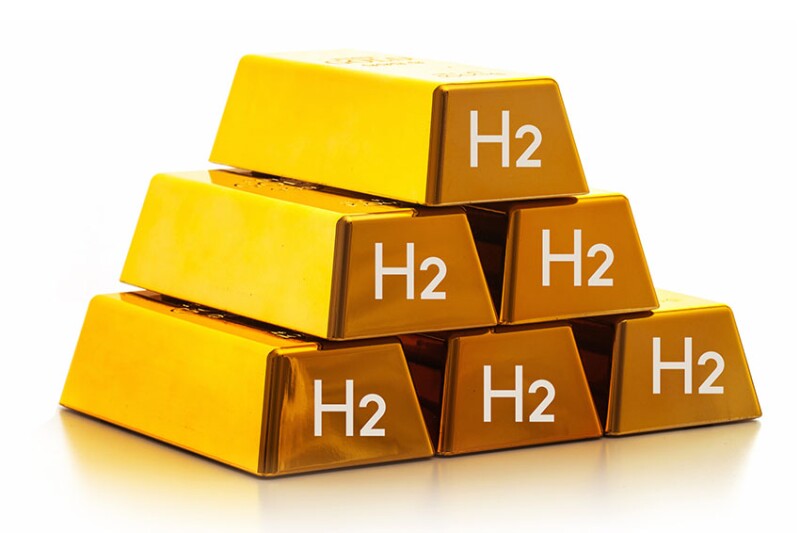A gold strike was announced in late October. But in this case the gold was naturally occurring hydrogen in a former coal basin.
Known as “white” or “gold” hydrogen, the reported discovery of naturally formed underground hydrogen was made in northeastern France’s Lorraine coal basin, a region between France and Germany. The last coal mine was shut down 20 years ago.
Researchers at the French National Centre of Scientific Research (CNRS) were testing a probe designed to analyze gases dissolved in the water of deep underground rock formations, looking for methane, when they detected hydrogen concentrations at depths of 1100 m (14%) and 1250 m (20%).
Their calculations estimated the deposits’ potential as between 6 and 250 million metric tons of hydrogen.
This wasn’t their first discovery of underground hydrogen in the area. Philippe de Donato and Jacques Pironon made a similar finding “by chance” as part of the Regalor research project in collaboration with Française de l’Energie (FDE), an independent multienergy company, the University of Lorraine, and CNRS.
FDE announced the discovery in a press release in May, saying the measurements of hydrogen were made in its previously drilled Folschviller wellsite in the carboniferous aquifer of the Lorraine basin.
Launched in 2018, the project’s aim was to confirm an assessment carried out in 2012 by France’s IFPEN petroleum and new energies institute. After analyzing a sample of the soil under the basin, the institute concluded that it contained 370 billion m3 of methane, which represents 8 years of gas consumption in France.
De Donato and Pironon said, “The work carried out within the framework of the Regalor project has made it possible to demonstrate that the fluids within the carboniferous formations of the Lorraine mining basin are very significantly enriched in hydrogen, with a measured concentration of 15% at 1093 m depth and estimated at 98% at 3000 m depth.”
FDE said in May that it applied for an exclusive mining exploration permit for the exploration of natural hydrogen in the basin. The permit covers an area of 2254 km2 in the Grand Est region. The company said a site for a pilot will be identified based on the results obtained and then built to initiate local production and recovery of natural hydrogen in the Grand Est Region. In its October investor update, FDE said measurements will be performed in three of its existing wells by the end of the year to determine the extent of the hydrogen deposit.
Reservoirs have also been discovered in the US, Canada, Finland, the Philippines, Australia, Brazil, Oman, Turkey, and Mali.
In Mali, the Bourakebougou water well, Bougou-1, was drilled in 1987 in the Taoudeni Basin, a large sedimentary system present mainly in Algeria, Mauritania, and Mali. The well was cemented after a gas explosion occurred during drilling operations at a measured depth of 112 m.
Unplugged in 2011 for use as a pilot well for local hydrogen production, gas was reported comprising 98% hydrogen, 1% nitrogen, and 1% methane. Hydrogen was then produced as an energy resource to supply local electricity through a company named Petroma, renamed Hydroma. From 2017 to 2019, the company drilled 24 wells.
Among the new breed of gold prospectors are several startup companies including Natural Hydrogen Energy, Koloma, Helios Aragon, Gold Hydrogen, HyTerra, and H2Au.
Helios Aragon owns exploration permits in northern Spain’s Aragon region and will begin drilling the Monzon-2 appraisal well in 2024 at a cost of $12 million. Estimates for the well are 1.1 million tons of hydrogen, and the company claims the Monzon field holds 5 to 10 million tons within its permits and more than 100 million tons in the region.
Natural Hydrogen Energy and HyTerra claim the “first wildcat well targeting natural hydrogen in Nebraska,” the Hoarty well at Project Geneva. HyTerra also holds leases in the Nemaha Ridge in Kansas.
The cost advantages of subsurface hydrogen are frequently cited by the early prospectors. For example, the wells in Mali have the potential to generate hydrogen gas at a cost of 50 cents/kg, which is only one-tenth the cost of producing hydrogen via electrolysis using solar, wind, geothermal, or other renewable energy sources.
If commercialization and economies of scale pan out, this may become the gold standard for hydrogen energy.
For Further Reading
The Curious Case of Geologic Hydrogen: Assessing its Potential as a Near-Term Clean Energy Source by E.M. Yedinak, US Department of Energy, Advanced Research Projects Agency-Energy.
The Occurrence and Geoscience of Natural Hydrogen: A Comprehensive Review by V. Zgonnik, Natural Hydrogen Energy LLC.


